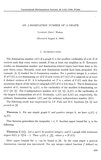Article
Full entry |
 PDF
(1.0 MB)
Feedback
PDF
(1.0 MB)
Feedback
 PDF
(1.0 MB)
Feedback
PDF
(1.0 MB)
Feedback
References:
[1] Y. Caro and Y. Roditty: A note on the $k$-domination number of a graph. Internat. J. Math. & Math. Sci. 13 (1990), no. 1, 205–206. DOI 10.1155/S016117129000031X | MR 1038667
[2] P. Erdös: On some extremal problems in graph theory. Israel J. of Mathematics 3 (1965), 113–116. DOI 10.1007/BF02760037 | MR 0190027
[3] O. Favaron: On a conjecture of Fink and Jacobson concerning $k$-domination and $k$-dependence. J. of Combinatorial Theory, Ser B 39 (1985), 101–102. DOI 10.1016/0095-8956(85)90040-1 | MR 0805459 | Zbl 0583.05049
[4] J.F. Fink and M.S. Jacobson: $n$-domination in graphs. Graph Theory with Applications to Algorithms and Computer Science, John Wiley & Sons, New York, 1985, pp. 283–300. MR 0812671
[5] J.F. Fink and M.S. Jacobson: On $n$-domination, $n$-dependence and forbidden subgraphs. Graph Theory with Applications to Algorithms and Computer Science, John Wiley & Sons, New York, 1985, pp. 301–311. MR 0812672
[6] S.T. Hedetniemi: Hereditary properties of graphs. J. of Combinatorial Theory, Ser B 14 (1973), 94–99. DOI 10.1016/S0095-8956(73)80009-7 | MR 0316313
[7] F. Jaeger and C. Payan: Relations du type Nordhaus–Gaddum pour le nombre d’absorption d’un graphe simple. CR Acad. Sci., Ser. A 274 (1972), 728–730. MR 0294161
[8] R. Laskar and H.B. Walikar: On domination related concepts in graph theory. Combinatorics and Graph Theory, S.B. Rao (ed.), Lecture Notes in Math. 885, Springer-Verlag, Berlin, Heidelberg, New York, 1981, pp. 308–320. MR 0655630
[9] C. Stracke and L. Volkmann: A new domination conception. J. Graph Theory 17 (1993), no. 3, 315–323. DOI 10.1002/jgt.3190170306 | MR 1220992

